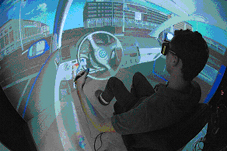
The use of Virtual Reality technology for the product engineering process in the automotive industry has a lot of potential in particular in the area of usability and reachability studies. We analyzed the manipulation of knobs, controls, flaps, mirrors and other components in a real car and classified them with respect to their constraints. Based on this classification, we developed a set of pseudo-physical direct interaction techniques, which closely approximate the real world behavior without employing a force-feedback device. Our approach uses a hierarchical grasp heuristic to decouple the interaction from the collision of the fingers with the virtual car components. This approach makes the interaction more robust while no haptic feedback is available. A pilot study of our implementation revealed that our direct manipulation techniques are a good step towards more realistic interaction with virtual car interiors.
Documents and Further Information
- M. Moehring and B. Froehlich:
Pseudo-Physical Interaction in a Virtual Car Interior
Accepted for IPT/EGVE Workshop 2005, Aalborg, Denmark - Diploma Thesis by Mathias Möhring
